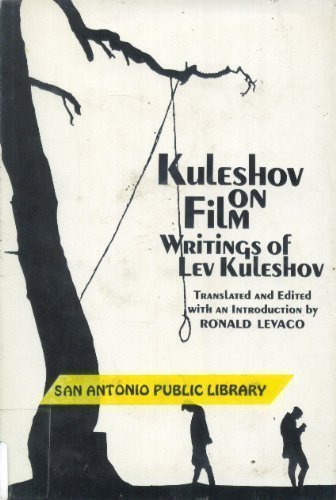Kuleshov on Film: Writings by Lev Kuleshov pdf download
Par guinyard josephine le dimanche, mai 1 2016, 01:21 - Lien permanent
Kuleshov on Film: Writings by Lev Kuleshov by Lev Vladimirovich Kuleshov, Ronald Levaco


Kuleshov on Film: Writings by Lev Kuleshov Lev Vladimirovich Kuleshov, Ronald Levaco ebook
Publisher: Univ of California Pr
Page: 121
ISBN: 0520026594, 9780520026599
Format: pdf
Kuleshov on Film: Writings by Lev Kuleshov. Lev Vladimirovich Kuleshov, Ronald Levaco. Chernova Nikolaj Gorich Lev Kuleshov Vitol'd Polonskij. He conducted a test At the time, the experiment served to show the usefulness and power of film editing, demonstrating how the viewer tends to bring their own emotions to the edited sequence of images and attributing their reactions to the actors. In his study entitled Kuleshov's Experiments and the New Anthropology of the Actor, Mikhail Yampolsky demonstrates how Kuleshov's montage theory can be derived from a new concept of the actor and acting, elaborated first of all in the theatrical practice of 1910s. After seeing the montage, that would change the perception, or increase the emotion that a reader imagines? Genre, Melodramas [romance, love story]. This technique, described by critic Paul Arthur as “metaphoric The diametrical separation between films critically assembled from newsreels and the formalist “played film” frequently appears in the writings of Soviet editors. It has to do with context and editing, and how the placement of images can affect perception. In the early 1900′s, a Russian filmmaker by the name of Lev Kuleshov came to the conclusion that two disparate shots edited one after the other are processed “together” in the minds of the audience. Director, Vitol'd Polonskij Lev Kuleshov. She explains it this way: "Lev Kuleshov, a Russian filmaker, edited a short film using static images of an actor's face alternated with shots of a plate of soup, a girl at play, and a coffin. Since the beginning of the film era people have been watching, and talking about, and writing about movies. Download Kuleshov on Film: Writings by Lev Kuleshov. Doublier, described as “the spiritual ancestor” of Lev Kuleshov, the Soviet montage theorist, uses the metaphoric properties of film to analogize the event where images do not exist. It is the specificity of Hungarian film theoretical writings that in explaining the new medium's novelty they resort to aesthetic terms, and aesthetics is a primary interpretative model instead of social or cultural ones. The year after The Gold Rush and Battleship Potemkin, Eisenstein's teacher Kuleshov turned in his own gold rush masterpiece. Lev Kuleshov was an early Soviet director, possibly one of the first film theorists of montage, who worked prior to Eisenstein's appearance in film.
Process Piping: The Complete Guide to Asme B31.3 download